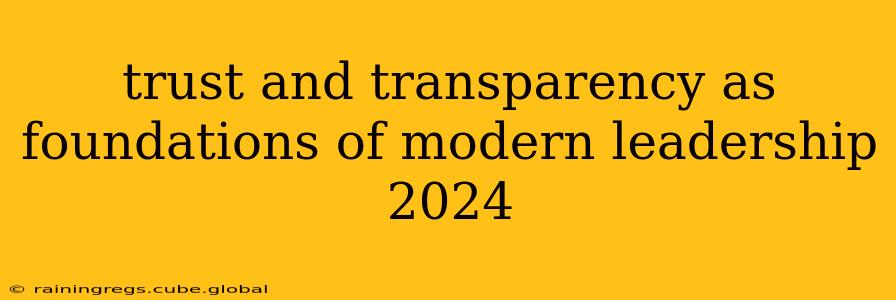In today's rapidly evolving world, leadership is no longer defined by traditional hierarchies and top-down directives. The modern landscape demands a different approach, one built on the unshakeable foundations of trust and transparency. These aren't simply buzzwords; they are essential ingredients for fostering strong teams, driving innovation, and navigating the complexities of the 21st-century workplace. This is particularly crucial in 2024, a year marked by ongoing global uncertainty and the need for adaptable, resilient leadership.
Why Trust and Transparency Matter in 2024
The tumultuous events of recent years have highlighted the crucial role of trust and transparency in leadership. Employees, customers, and stakeholders alike are increasingly demanding authenticity and open communication from those in positions of power. A lack of transparency can breed cynicism, erode morale, and ultimately damage an organization's reputation. Conversely, leaders who prioritize transparency and build trust foster a more collaborative, engaged, and productive work environment. This is especially relevant in 2024 as businesses grapple with economic headwinds, technological disruptions, and evolving societal expectations.
Building Trust: More Than Just Words
Building trust is a continuous process, not a one-time event. It requires consistent action and a genuine commitment to ethical conduct. Here are key strategies for cultivating trust among your team and stakeholders:
- Lead by Example: Demonstrate integrity in your own actions. Be accountable for your decisions and admit mistakes. Transparency starts at the top.
- Open Communication: Encourage open dialogue and feedback. Create safe spaces for employees to express concerns and opinions without fear of retribution.
- Active Listening: Truly listen to your team members and stakeholders. Understand their perspectives and concerns.
- Fairness and Equity: Ensure that all individuals are treated fairly and equitably, regardless of their background or position.
- Empathy and Compassion: Demonstrate genuine care and concern for the well-being of your team.
Transparency: Shining a Light on Operations
Transparency extends beyond simply sharing information; it's about proactively fostering an environment where information flows freely and openly. Here’s how to achieve greater transparency:
- Clear Communication Strategies: Implement clear communication channels and processes to ensure that information is disseminated effectively and consistently. Regular updates, town hall meetings, and open forums can all play a vital role.
- Data-Driven Decision Making: Make decisions based on data and evidence, and share the rationale behind those decisions with your team. This demonstrates a commitment to objectivity and fairness.
- Accountability and Responsibility: Establish clear lines of accountability and responsibility. When things go wrong, be transparent about the reasons why and the steps being taken to address the issue.
- Embrace Feedback: Actively solicit and respond to feedback from employees, customers, and stakeholders. This shows that you value their input and are committed to continuous improvement.
What are the benefits of trust and transparency in leadership?
The benefits of cultivating trust and transparency are numerous and far-reaching. They include improved employee morale, increased productivity, stronger customer relationships, enhanced brand reputation, and greater resilience during times of crisis.
How can leaders foster transparency within their organizations?
Leaders can foster transparency through clear communication channels, data-driven decision-making, open feedback mechanisms, and a commitment to accountability.
What are the challenges of maintaining trust and transparency?
Maintaining trust and transparency can be challenging due to factors such as organizational culture, fear of negative consequences, and the complexity of modern business environments. However, the benefits far outweigh the challenges.
What are some examples of transparent leadership?
Examples of transparent leadership include openly sharing financial information, proactively addressing concerns, and actively soliciting feedback from all stakeholders.
In conclusion, trust and transparency are not just desirable qualities for modern leaders; they are fundamental requirements for success in 2024 and beyond. By prioritizing these values, leaders can build stronger teams, foster innovation, navigate uncertainty, and create a positive impact on their organizations and the wider world. The journey towards establishing trust and transparency is an ongoing commitment, demanding consistent effort and a genuine dedication to ethical and responsible leadership.
